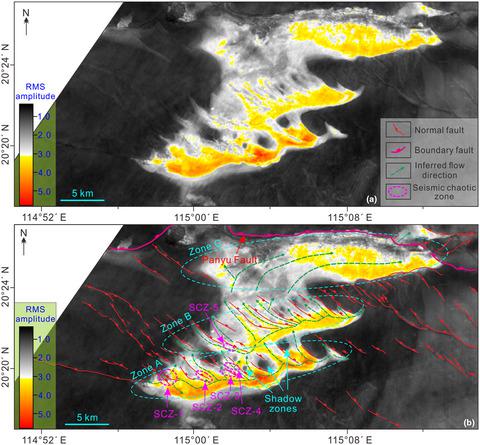当前位置:
X-MOL 学术
›
Basin Res.
›
论文详情
Our official English website, www.x-mol.net, welcomes your
feedback! (Note: you will need to create a separate account there.)
The interplay of stratal and vertical migration pathways in shallow hydrocarbon plumbing systems
Basin Research ( IF 2.8 ) Pub Date : 2021-02-07 , DOI: 10.1111/bre.12552 Qiliang Sun 1, 2, 3, 4 , Joe Cartwright 4 , Martino Foschi 4 , Xiangyang Lu 1, 3 , Xinong Xie 1, 3
Basin Research ( IF 2.8 ) Pub Date : 2021-02-07 , DOI: 10.1111/bre.12552 Qiliang Sun 1, 2, 3, 4 , Joe Cartwright 4 , Martino Foschi 4 , Xiangyang Lu 1, 3 , Xinong Xie 1, 3
Affiliation

|
Hydrocarbon plumbing systems have been extensively documented in the past two decades using high-resolution 3D seismic data, exploiting the ability of seismic imaging techniques to reveal the subsurface geometry of gas charged sediments. In this paper, we present a detailed study of a hydrocarbon plumbing system from the South China Sea, that involves both vertical and lateral (stratal) hydrocarbon migration in Miocene to Recent clastic sediments that comprise multilayer stacking of thinly layered clays, silts and sands. We show that a transtensive fault system that provides lateral seal for fault-dip traps of deep Miocene reservoirs, and offers a vertical pathway for migration to shallower silty units. These silty units in turn form a ‘spillway’ in a regional, northward migration path. This path involves filling each shallow fault-dip trap to spill point towards the fault tips, with stratal migration forced around the outer flanks of the fault-related folds. Successive fill-to-spill leads to a continuous trail of amplitude anomalies that merge into a continuous, larger, gas-charged anomaly pattern. The migrating gas finally accumulates within a zone bounded by a large boundary fault with full juxtaposition seal. The pattern of anomaly distribution suggests that the hydrocarbon migration has been active in the Late Pleistocene and is probably continuing at the present day. Hence this plumbing system may be one of very few examples described to date in which dynamic hydrocarbon migration pathways have been directly imaged by seismic data.
中文翻译:

浅层油气管道系统中地层和垂直运移路径的相互作用
在过去的二十年中,使用高分辨率的3D地震数据对碳氢化合物管道系统进行了广泛的记录,并利用地震成像技术揭示了带气沉积物的地下几何结构的能力。在本文中,我们对南海的一个油气管道系统进行了详细的研究,该系统涉及中新世的垂直和横向(地层)油气运移到最近的碎屑沉积物中,这些沉积物包括薄层粘土,粉砂和砂的多层堆积。我们显示了一个伸展性断裂系统,它为中新世深层储层的断层倾陷陷阱提供侧向封闭,并为向浅粉质单元的迁移提供了一条垂直通道。这些粉质单位又在区域性的北移路径中形成“溢洪道”。这条路径涉及填充每个浅层断层倾陷陷阱,使溢出点指向断层尖端,迫使地层运移围绕断层相关褶皱的外侧面。连续的填充到溢出导致幅度异常的连续轨迹,这些异常合并为连续的较大的充气异常模式。最终,迁移的气体聚集在一个由大边界断层界定的带完全并置密封的区域内。异常分布的模式表明,烃类运移在更新世晚期很活跃,并且可能在今天仍在继续。因此,该管道系统可能是迄今为止描述的极少数示例之一,其中动态碳氢化合物迁移路径已通过地震数据直接成像。地层迁移被迫围绕断层褶皱的外侧面。连续的填充到溢出导致幅度异常的连续轨迹,这些异常合并为连续的较大的充气异常模式。最终,迁移的气体聚集在一个由大边界断层界定的带完全并置密封的区域内。异常分布的模式表明,烃类运移在更新世晚期很活跃,并且可能在今天仍在继续。因此,该管道系统可能是迄今为止描述的极少数示例之一,其中动态碳氢化合物迁移路径已通过地震数据直接成像。地层迁移被迫围绕断层褶皱的外侧面。连续的填充到溢出导致幅度异常的连续轨迹,这些异常合并为连续的较大的充气异常模式。最终,迁移的气体聚集在一个由大边界断层界定的带完全并置密封的区域内。异常分布的模式表明,烃类运移在更新世晚期很活跃,并且可能在今天仍在继续。因此,该管道系统可能是迄今为止描述的极少数示例之一,其中动态碳氢化合物迁移路径已通过地震数据直接成像。最终,迁移的气体聚集在一个由大边界断层界定的带完全并置密封的区域内。异常分布的模式表明,烃类运移在更新世晚期很活跃,并且可能在今天仍在继续。因此,该管道系统可能是迄今为止描述的极少数示例之一,其中动态碳氢化合物迁移路径已通过地震数据直接成像。最终,迁移的气体聚集在一个由大边界断层界定的带完全并置密封的区域内。异常分布的模式表明,烃类运移在更新世晚期很活跃,并且可能在今天仍在继续。因此,该管道系统可能是迄今为止描述的极少数示例之一,其中动态碳氢化合物迁移路径已通过地震数据直接成像。
更新日期:2021-02-07
中文翻译:

浅层油气管道系统中地层和垂直运移路径的相互作用
在过去的二十年中,使用高分辨率的3D地震数据对碳氢化合物管道系统进行了广泛的记录,并利用地震成像技术揭示了带气沉积物的地下几何结构的能力。在本文中,我们对南海的一个油气管道系统进行了详细的研究,该系统涉及中新世的垂直和横向(地层)油气运移到最近的碎屑沉积物中,这些沉积物包括薄层粘土,粉砂和砂的多层堆积。我们显示了一个伸展性断裂系统,它为中新世深层储层的断层倾陷陷阱提供侧向封闭,并为向浅粉质单元的迁移提供了一条垂直通道。这些粉质单位又在区域性的北移路径中形成“溢洪道”。这条路径涉及填充每个浅层断层倾陷陷阱,使溢出点指向断层尖端,迫使地层运移围绕断层相关褶皱的外侧面。连续的填充到溢出导致幅度异常的连续轨迹,这些异常合并为连续的较大的充气异常模式。最终,迁移的气体聚集在一个由大边界断层界定的带完全并置密封的区域内。异常分布的模式表明,烃类运移在更新世晚期很活跃,并且可能在今天仍在继续。因此,该管道系统可能是迄今为止描述的极少数示例之一,其中动态碳氢化合物迁移路径已通过地震数据直接成像。地层迁移被迫围绕断层褶皱的外侧面。连续的填充到溢出导致幅度异常的连续轨迹,这些异常合并为连续的较大的充气异常模式。最终,迁移的气体聚集在一个由大边界断层界定的带完全并置密封的区域内。异常分布的模式表明,烃类运移在更新世晚期很活跃,并且可能在今天仍在继续。因此,该管道系统可能是迄今为止描述的极少数示例之一,其中动态碳氢化合物迁移路径已通过地震数据直接成像。地层迁移被迫围绕断层褶皱的外侧面。连续的填充到溢出导致幅度异常的连续轨迹,这些异常合并为连续的较大的充气异常模式。最终,迁移的气体聚集在一个由大边界断层界定的带完全并置密封的区域内。异常分布的模式表明,烃类运移在更新世晚期很活跃,并且可能在今天仍在继续。因此,该管道系统可能是迄今为止描述的极少数示例之一,其中动态碳氢化合物迁移路径已通过地震数据直接成像。最终,迁移的气体聚集在一个由大边界断层界定的带完全并置密封的区域内。异常分布的模式表明,烃类运移在更新世晚期很活跃,并且可能在今天仍在继续。因此,该管道系统可能是迄今为止描述的极少数示例之一,其中动态碳氢化合物迁移路径已通过地震数据直接成像。最终,迁移的气体聚集在一个由大边界断层界定的带完全并置密封的区域内。异常分布的模式表明,烃类运移在更新世晚期很活跃,并且可能在今天仍在继续。因此,该管道系统可能是迄今为止描述的极少数示例之一,其中动态碳氢化合物迁移路径已通过地震数据直接成像。











































 京公网安备 11010802027423号
京公网安备 11010802027423号